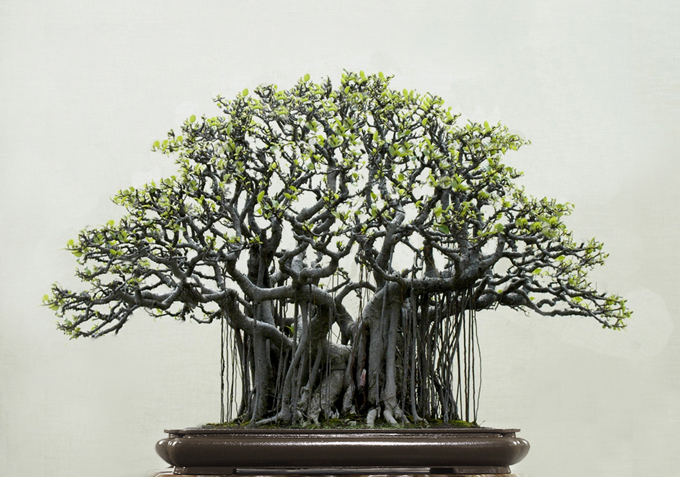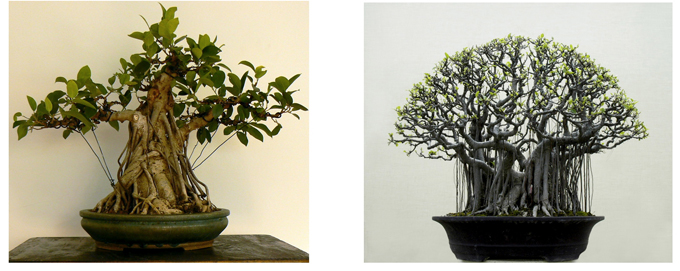 Robert Steven’s digital simulation of a tree that was submitted by Josua.
Robert Steven’s digital simulation of a tree that was submitted by Josua.
The eye of a master
Sometimes Robert Steven’s simulations are strikingly radical and completely unexpected. In this case, what Robert has presented isn’t so radical. You might even say, his improvements are fairly obvious. Still, obvious or not, Robert’s expert eye and touch always seem to elevate the trees from ordinary to sublime.
 The tree on the left was submitted by Anthony. The one on the right was submitted by Josua. Both are ficus.
The tree on the left was submitted by Anthony. The one on the right was submitted by Josua. Both are ficus.
Robert’s Critique
I put these two bonsai together for my critique and as they are both Ficus. My simulation is for Josua’s tree, but I believe Anthony will also learn from it.
Anthony’s tree is still immature; the ramification (branching) needs to be developed. No matter how old or well developed the trunk appears, if the ramification is not ideal, it will never look like a mature tree in nature. From the initial form, I can also tell the “textbook mind set” with the 1-2-3 branching rule and apical crown which does not portray the character of ficus (or a deciduous tree) which should be wide spread. The aerial roots are also messy.
For Josua’s tree, the basic features of the trunk and aerial roots are nice, they show the character of an old ficus, but the crown is too small, too round and too neat. This creates an artificial look. The pot is also too deep which distracts the tree from the overall composition.
In order to portray a large old ficus in nature, the crown should be much wider: with uneven foliage edges. This will give the tree more natural look. The ramification still looks rather messy and too dense, it should be further refined and simplified. This especially applies to the twigs. If you do this, your bonsai will look neat and clean with sufficient spaces which also good for the lights to get through. A shallow pot will improve the tree’s presentation as you can see in the simulation.
General comments
There is more than one way to design any bonsai and my critiques and recommended solutions might not always fit your taste and personal preferences, but I always try to give my opinion based on artistic and horticultural principles.
To understand my concepts better, please read my books Vision of My Soul and Mission of Transformation which are available at Stone Lantern.
Once in a while I see a photo of a tree that causes me to completely rethink my approach. The tree from Josua smacked me in the face this morning. It looks as though he’s wired every branch of this tree to create this elegant form. And here I’ve been just clip-and-growing my banyan style ficus trees, content with a big spreading crown of foliage and cool roots. I wonder how he keeps wire from scarring if he is wiring. Beautiful and inspiring.
Robert,
Thank you for emphasizing “uneven foliage edges.” So many “specimen” trees particularly those following strict Japanese design principles have rounded edges that make a tree look like a topiary from Disney World.
I just acquired a Ficus microcarpa/retusa very much like the one submitted by Anthony. I wouldn’t be surprised if they came from the same nursery somewhere in the tropics. I do not live in the tropics, and I am wondering if there are any techniques that have been found effective for developing aerial roots. The ungrounded aerial roots on my ficus have withered up. I was thinking about scoring the bark, applying rooting hormone, and filling a drinking straw or tube filled with damp sand, and attaching/propping the tube between the soil line and the wound. The tree is now living outdoors and being misted on the hour, which should bring up the humidity level, but in the fall I will bring it indoors and use it as a houseplant without the TLC. Again, open to suggestions as I develop this tree (now with some of Robert’s theory to help guide me).
Carol, if you can do clip-grow, why should you wiring ? Clip-and-grow is the best technique for deciduous tree since many people make mistake by doing too much wiring like they do on junipers. Wiring in deciduos bonsai is just for initial direction…
You are right Owen. uneven foliage adges make a bonsai looks natural and too refined foliage look artificial..indeed a very simply logic. Most of our bonsai are portraying a close up tree with all the physical details clearly seen, so when you give it a very neat refined foliage, this will not fit to the nature because ONLY very far distance tree is optically viewed with round and neat foliage edges; so a close up trunk features with far distance foliage..two different sources of fact..and our sub-concious or cognitive sense reject it as something unusual.
No matter how dense a tree is, if you look at it from close up, there are spaces, gaps in between with contour, not a neat refined foliage adges. Sound logical ? This is how and why most of the Chinese bonsai look so natural…
Al, some ficul easily give aereal roots and some not, but give less watering normally will stimulate the aereal roots to grow. Using straws is the correct way to direct them down and will give a straight powerful aereal roots; but you should cut the straw opened before you inserted the root as it will make you easier to take the straw out without damaging the root.
The main problem with Anthony’s tree is the “textbook mind-set”, 1-2-3 branching and the very common mistake..the single apical line to form the crown. This is for conifers, not deciduous trees… and last but not least, the ramification structure.
This Ficus simulation is fantastic, but maybe a bit idealistic. Truth, however, is that something similar can be achieved. You can work with older and straighter material and wiring is the answer. Wiring boils own to correcting earlier mistakes or chances to use clip and grow being missed. Ficus is very lenient and wiring can achieve amazing results. Watch the wiring! Check on the branches jumping back to straighter forms somewhat later. Wire marks grow over easily and may add character because Ficus has smooth bark and some marks on the bark add to age image!